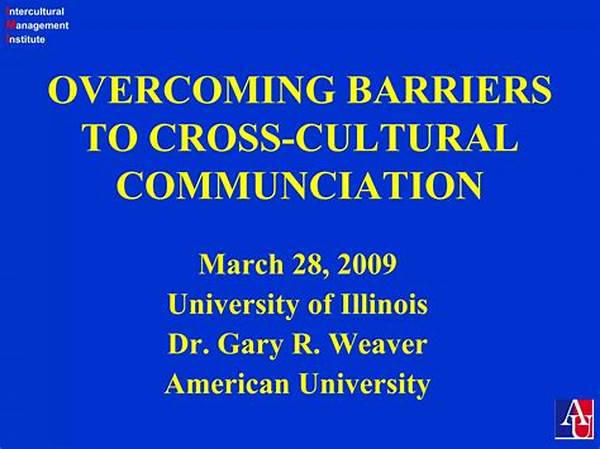In today’s globalized society, cross-cultural communication has become a vital competency for individuals and organizations alike. The ability to communicate effectively with people from diverse cultural backgrounds is not only a desirable skill but also a necessity. Within this context, overcoming barriers in cross-cultural communication is crucial for achieving mutual understanding and fostering cooperative relationships. This article aims to explore the challenges inherent in cross-cultural interactions and provide strategies to surmount these obstacles.
Read Now : Learner-centered Education Models
Understanding Cross-Cultural Communication Challenges
Cross-cultural communication involves numerous challenges that arise from differences in language, cultural norms, and non-verbal expressions. A significant barrier in cross-cultural communication is language diversity, which can lead to misunderstandings or misinterpretations of messages. Cultural norms also play a critical role as they shape the way individuals communicate, including their expectations and interpretations of specific gestures or expressions. Overcoming barriers in cross-cultural communication requires a comprehensive understanding of these cultural nuances. It is essential to recognize that communication is not only about words but also understanding the context, tone, and emotions behind them. Effective cross-cultural communication necessitates an open-minded approach where individuals are willing to learn and respect the cultural values of others. By doing so, they can bridge communication gaps and develop more effective and meaningful interactions. Moreover, understanding cultural differences and exhibit cultural sensitivity foster a more inclusive and harmonious environment where all participants feel valued and heard.
Strategies to Overcome Communication Barriers
Overcoming barriers in cross-cultural communication involves embracing several key strategies:
1. Cultural Awareness: Cultivating an awareness of one’s own cultural assumptions as well as those of others is crucial. This self-awareness helps in recognizing biases and understanding differing perspectives, which are essential in facilitating effective communication.
2. Language Proficiency: Developing language skills or utilizing translation services can bridge language gaps. Being proficient in a second language or employing interpreters can significantly enhance clarity and understanding.
3. Non-Verbal Communication: Understanding and respecting non-verbal cues from different cultures can prevent misinterpretations. Gestures, body language, and facial expressions can vary widely across cultures.
4. Active Listening: Practicing active listening, which involves fully concentrating, understanding, and responding to what is being said, is fundamental. This approach ensures that speakers feel heard and validated.
5. Adaptability and Flexibility: Being adaptable and open to adjusting communication styles as per the cultural context can aid in overcoming barriers in cross-cultural communication. Flexibility in approach usually results in more effective interactions.
Read Now : Virtual Leadership Training Courses
The Role of Technology in Cross-Cultural Communication
Technology plays a pivotal role in overcoming barriers in cross-cultural communication. The advent of digital communication tools has significantly reduced geographical boundaries, allowing individuals from diverse cultural backgrounds to collaborate seamlessly. Instant messaging, video conferencing, and collaboration platforms have facilitated real-time communication, ensuring that cultural differences are bridged more efficiently. However, reliance on technology itself can introduce new barriers, such as differing levels of digital literacy or varied preferences for communication platforms. As such, careful consideration and selection of appropriate technological tools are essential in ensuring inclusivity and understanding in cross-cultural exchanges.
Communication Styles and Cultural Sensitivity
Understanding various communication styles is imperative for overcoming barriers in cross-cultural communication. People from different cultures might have distinct preferences for direct or indirect communication, formal or informal interaction, and high or low context communication. Cultivating cultural sensitivity entails being mindful of these differences and adapting accordingly. For instance, in high-context cultures, much of the communication relies on context and non-verbal cues, while in low-context cultures, explicit verbal communication is preferred. Being sensitive to such cultural distinctions not only improves communication efficacy but also demonstrates respect for differing cultural norms.
Fostering Inclusivity in Multicultural Environments
Inclusivity is an essential component for overcoming barriers in cross-cultural communication. Organizations and individuals must create environments where everyone, regardless of their cultural background, feels valued and included. This involves not only understanding cultural differences but actively promoting diversity and inclusion through policies, practices, and behaviors. Encouraging open dialogue, providing cross-cultural training programs, and recognizing cultural contributions are effective ways to promote an inclusive atmosphere. By fostering inclusivity, individuals and organizations can enhance collaboration, creativity, and mutual respect in cross-cultural interactions.
Conclusion: Embracing and Overcoming Cultural Barriers
In conclusion, overcoming barriers in cross-cultural communication is a multifaceted endeavor that requires awareness, adaptability, and genuine respect for cultural diversity. By understanding and acknowledging the unique challenges that arise from cultural differences, individuals and organizations can strategize effectively to enhance communication. Embracing cultural diversity, developing cultural competence, and employing effective communication strategies not only enhance personal and professional relationships but also contribute to a more cohesive and harmonious global society. It is through these deliberate efforts and continuous learning opportunities that overcoming barriers in cross-cultural communication becomes a reality.
